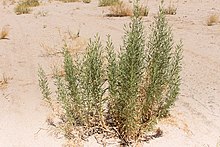Pechuel-loeschea
| Pechuel-loeschea | |
|---|---|

| |
| Scientific classification | |
| Kingdom: | Plantae |
| Clade: | Tracheophytes |
| Clade: | Angiosperms |
| Clade: | Eudicots |
| Clade: | Asterids |
| Order: | Asterales |
| Family: | Asteraceae |
| Subfamily: | Asteroideae |
| Tribe: | Inuleae |
| Genus: | Pechuel-loeschea O.Hoffm. |
| Species: | P. leubnitziae
|
| Binomial name | |
| Pechuel-loeschea leubnitziae | |
| Synonyms[1] | |
| |
Pechuel-loeschea, (common names; stinkbush,[2] sweatbush,[3] or bitterbos,[2][4]) is a monotypic genus of African plants in the elecampane tribe within the sunflower family, and named after the German plant collector and geographer Eduard Pechuël-Loesche (1840-1913).[5]
The only known species is Pechuel-loeschea leubnitziae,[6][7] (or 'wild sage'[3][8]) which is native to Angola, Botswana, Eswatini, Mozambique, Namibia, Zimbabwe and the Cape Provinces and the Northern Provinces, (in South Africa).[9] The Latin specific epithet of leubnitziae refers to Leubnitzia, the maiden name of Pechuel-Loesche's wife.[3]
Description
[edit]Strongly aromatic shrubby perennial herb. It grows up to 1.3 m (4 ft 3 in) tall. Most parts are densely grey-velvety and with short glandular hairs. It has alternately arranged leaves, which are (sub)sessile (without a leaf stalk). They are narrowly obovate-elliptic in shape and about 4.5 cm (2 in) long and 0.7 cm wide. They are velvety-grey on both leaf surfaces with a midrib prominent also on both surfaces. The margin is entire (smooth). It blooms between March and July. It has a capitula (a dense cluster of sessile or subsessile flowers) which are terminal (at the end) of 1-3 in the leaf axils. They more or less funnel-shaped and up to 1.3 cm long. The involucral scales (surround the flower head) are greyish glandular and hairy. The florets are purple with the central ray florets absent.[3]
Habitat
[edit]It is found growing in alkaline and sandy soils in dry wooded grassland or open woodland. It is often found in large amount growing along roadsides and disturbed areas.[3]
References
[edit]- ^ Flann, C (ed) 2009+ Global Compositae Checklist
- ^ a b Umberto Quattrocchi CRC World Dictionary of Plant Names: Common Names, Scientific Names, Eponyms ... (1999), p. 1984, at Google Books
- ^ a b c d e "Flora of Zimbabwe: Species information: Pechuel-Loeschea leubnitziae". www.zimbabweflora.co.zw. Retrieved 9 November 2021.
- ^ Patricia Craven and Christine Marais Namib Flora: Swakopmund to the Giant Welwitschia Via Goanikontes (1986), p. 58, at Google Books
- ^ Burkhardt, Lotte (2018). Verzeichnis eponymischer Pflanzennamen – Erweiterte Edition [Index of Eponymic Plant Names – Extended Edition] (pdf) (in German). Berlin: Botanic Garden and Botanical Museum, Freie Universität Berlin. doi:10.3372/epolist2018. ISBN 978-3-946292-26-5. Retrieved 1 January 2021.
- ^ "Pechuel-Loeschea | Species Dictionary | Southern Africa | iSpot Nature". www.ispotnature.org. Retrieved 2017-08-16.
- ^ Gibbs Russell, G. E., W. G. M. Welman, E. Retief, K. L. Immelman, G. Germishuizen, B. J. Pienaar, M. Van Wyk & A. Nicholas. 1987. List of species of southern African plants. Memoirs of the Botanical Survey of South Africa 2(1–2): 1–152(pt. 1), 1–270(pt. 2).
- ^ Tedder, Michelle; Morris, Craig; Kirkman, Kevin P.; Trollope, Westleigh Matthew; Bonyongo, Mpaphi Casper (December 2012). "The influence of Pechuel-Loeschea leubnitziae (wild sage) on grass sward and soil seed bank composition". African Journal of Range and Forage Science. 29 (3): 101–107. Bibcode:2012AJRFS..29..101T. doi:10.2989/10220119.2012.720280.
- ^ "Pechuel-loeschea O.Hoffm. | Plants of the World Online | Kew Science". Plants of the World Online. Retrieved 9 November 2021.
